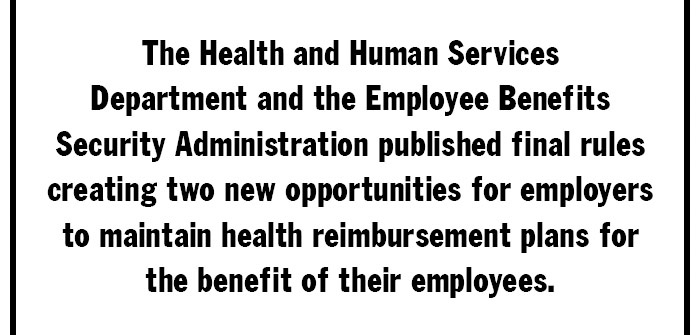In exciting news, the Health and Human Services Department and the Employee Benefits Security Administration published final rules creating two new opportunities for employers to maintain health reimbursement plans for the benefit of their employees. This article breaks down the need-to-know features of those rules as we get closer to the start of 2020, the first benefit plan year in which they can be applied.
Health Reimbursement Accounts
A Health Reimbursement Account (“HRA”) is an account-based group health plan that provides reimbursement for expenses for medical care up to a maximum dollar amount over a fixed period. HRAs provide tax advantages to the employer and the employee participating in them. HRAs are funded solely by employer contributions. While news coverage is generally focused on Health Savings Accounts (“HSAs”), HRAs are different from HSAs, where employees may contribute for their own health spending benefit.
Individual Coverage HRA
The first newly created option is the Individual Coverage HRA (“ICHRA”). ICHRAs allow employees to choose their own health care under the health care exchanges, and for employers to reimburse the cost of the insurance premiums tax-free. This is an option that was previously only available to small employers in limited circumstances.
Prior to the new rules, employers who wanted to reimburse employees for insurance premiums on the individual market were limited to offering a Qualified Small Employer HRA (“QSEHRA”). As you note by definition and title, QSEHRAs are only an option for certain employers. The employer must have fewer than 50 full-time employees and cannot offer a group health plan to their employees. ICHRAs expand the concept of QSEHRA to a broader group of employers and their employees.
Employers of any size can offer an ICHRA to reimburse employees for the cost of health insurance premiums on the individual market. However, employers cannot offer an employee a choice between an ICHRA and a group health plan; the employer must either offer an ICHRA or a group health plan.
Nevertheless, the rules permit employers to categorize employees based on certain employment distinctions providing some flexibility. Employers may offer an ICHRA to one class of employees, and a group health plan to another class. The class distinctions must be based on permissible job distinctions. If an employer offers a regular group health plan to one class of employees and an ICHRA to another class, then the number of employees in the class that is being offered the ICHRA will need to meet certain minimum size requirements.
As with most health plan options, employers must be aware of notice and disclosure requirements specific to ICHRAs. First, in order to offer an ICHRA, an employer will need to provide employees a notice about the new option 90 days before the start of the plan year in which the ICHRA will be offered. Second, employees participating in an ICHRA are required to provide both an annual and ongoing attestation that they are actually enrolled in individual health insurance coverage. The annual attestation should be completed prior to the effective date of each participant’s coverage under the ICHRA. The Department of Labor has provided model notices that employers can use to satisfy these requirements.
Excepted Benefit HRA
Excepted Benefit HRAs are the second new and exciting planning opportunity. Excepted Benefit HRAs allow the reimbursement of certain “excepted benefits,” such as medical expenses under the definition of Internal Revenue Code Section 213(d) that are not covered by the employer’s group health plan and premiums for COBRA coverage, short-term limited duration insurance, dental and vision coverage. Excepted Benefit HRAs have a maximum annual contribution limit, adjusted annually for inflation. Starting in 2020, the maximum annual contribution to an Excepted Benefit HRA is $1,800.
In order to offer an Excepted Benefit HRA, an employer must also offer group health coverage to the employees to whom it offers the Excepted Benefit HRA. However, the employees are not required to be enrolled in the group health plan. Although Excepted Benefit HRAs may sound similar to the currently available Limited Purpose HRAs, a Cafeteria Plan or even HSAs, unlike these other options, Excepted Benefit HRAs have an annual contribution limit and are solely funded by employer dollars. Excepted Benefit HRAs also reimburse a broader category of medical expenses, creating more opportunities to utilize funding mechanisms to save employer dollars or enhance benefits.
Unlike ICHRAs, Excepted Benefit HRAs do not have special notice requirements. Further, when an employer offers an Excepted Benefit HRA, they must offer it to all similarly situated employees. It should also be noted that employers cannot offer both an ICHRA and an Excepted Benefit HRA. However, these options are directed towards different purposes. ICHRAs are a good option for employers for whom a QSEHRA is not an option, but who would like to offer a benefit other than a traditional group health plan. Excepted Benefit HRAs are a good option for employers with a group health plan who are looking to offer an additional benefit to their employees.
To conclude, both ICHRAs and Excepted Benefit HRAs provide new options and flexibility for employers looking to provide healthcare as a benefit to their employees while saving money compared to traditional group health plans. However, utilizing non-traditional forms of reimbursement adds complexity. Employers should work with their advisors to ensure they understand how these options may benefit the employees’ health coverage while saving the employer money.
Gabrielle Hansen is an attorney with Barran Liebman LLP, where she represents employers in a variety of ERISA and employment matters. Contact her at 503-276-2112 or ghansen@barran.com.





